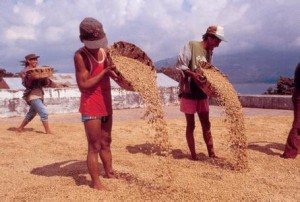Introduction to the treatment of raw coffee beans in the sun
Sun treatment will first identify sunken beans in the sink, that is, ripe or half-ripe beans are spread in the drying farm for natural drying. The specific time depends on the local climatic conditions, which usually takes two to four weeks. When the moisture of the coffee bean is reduced to 12%, then use a sheller to grind off the hard pulp and silver skin.
The sun treatment has a very high requirement on the climate, and if you encounter a rainy day in the sun, it will make the beans moist and moldy. When drying raw beans in the sun, the color is yellow, and the center will be brown after baking, rather than the white of washed beans. Sun beans have relatively better sweetness and mellow thickness, while less sour taste, but the quality is more unstable, there will be greater fluctuations. Due to the low cost of tanning, it is widely used not only in Ethiopia and Yemen, but also in Robbins grown in Africa and Indonesia.

1. Select beans: put freshly harvested coffee beans in the sink, ripe beans will sink, while unripe and overripe beans will float up and can be removed.
2. Drying: put the selected ripeness on the square for 5-6 days until it is fully dry. At this time, the surface of the raw bean turned dark brown and the moisture content was 13%.
3, shelling: after drying, the unbeautiful skin becomes fragile and falls off easily, which can be removed mechanically. Farms run by enterprises are all shelled by themselves, while small farms are handed over to the processing center for processing.
4. Selection and classification: enterprise farms will identify defective beans manually or mechanically, and select them. The manual selection method uses a transmission belt of about 1 meter, and several female workers sitting on both sides visually select bad beans. In some good farms, they are even selected several times until no defective beans are seen. The mechanical selection method uses mechanical discrimination to remove defective beans, followed by the classification process, which divides coffee beans into several quality grades according to the established criteria. Good coffee enters the selected coffee market, while poor coffee flows into the commercial coffee market.
5. Polishing: shelling can only remove the unattractive layer of beans. At this time, the silver film is still preserved in the outer layer of the seed, and the film must be mechanically ground.
Important Notice :
前街咖啡 FrontStreet Coffee has moved to new addredd:
FrontStreet Coffee Address: 315,Donghua East Road,GuangZhou
Tel:020 38364473
- Prev

Coffee knowledge the growth conditions of coffee
The planting conditions of Ethiopian coffee trees originating in Africa are tropical or subtropical, that is, between the south and north latitudes of 25 degrees; the ideal altitude is 500-2000 meters, and the warm climate with a temperature between 18-25 ℃ must have rainfall of 1500-2250 mm throughout the year, and the rainfall time should be able to match the flowering cycle of coffee trees; adequate sunshine, good ventilation and drainage
- Next

Coffee knowledge the growth process of coffee
Manual picking: less impurities, good taste, slow speed, high cost machine picking: many impurities, poor taste, high speed, low cost
Related
- Beginners will see the "Coffee pull flower" guide!
- What is the difference between ice blog purified milk and ordinary milk coffee?
- Why is the Philippines the largest producer of crops in Liberia?
- For coffee extraction, should the fine powder be retained?
- How does extracted espresso fill pressed powder? How much strength does it take to press the powder?
- How to make jasmine cold extract coffee? Is the jasmine + latte good?
- Will this little toy really make the coffee taste better? How does Lily Drip affect coffee extraction?
- Will the action of slapping the filter cup also affect coffee extraction?
- What's the difference between powder-to-water ratio and powder-to-liquid ratio?
- What is the Ethiopian local species? What does it have to do with Heirloom native species?

